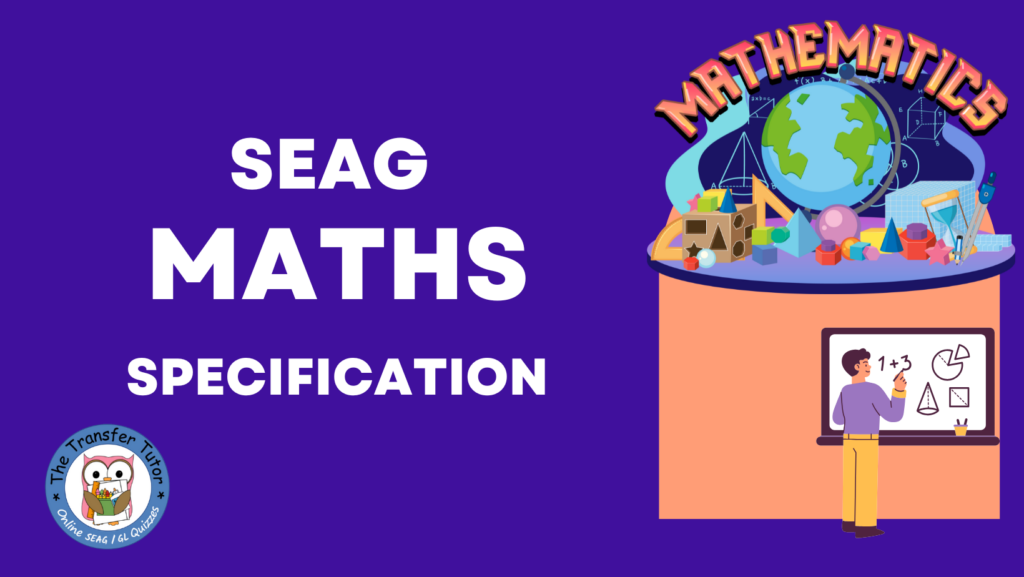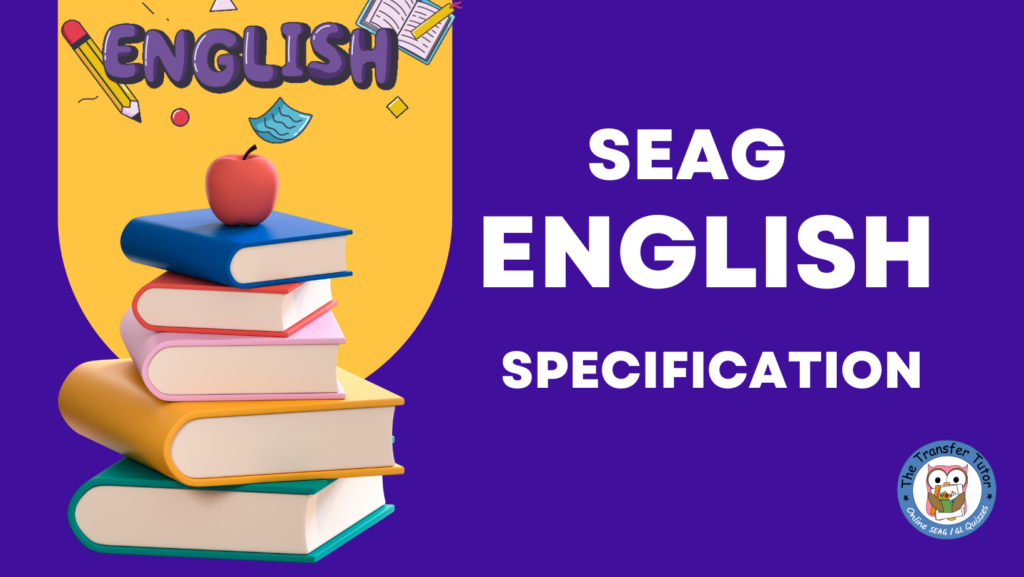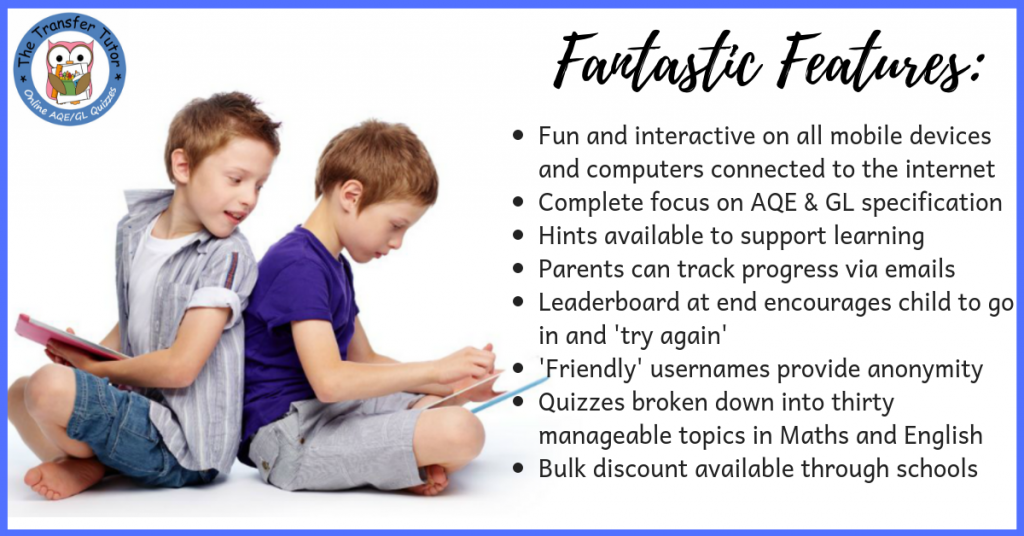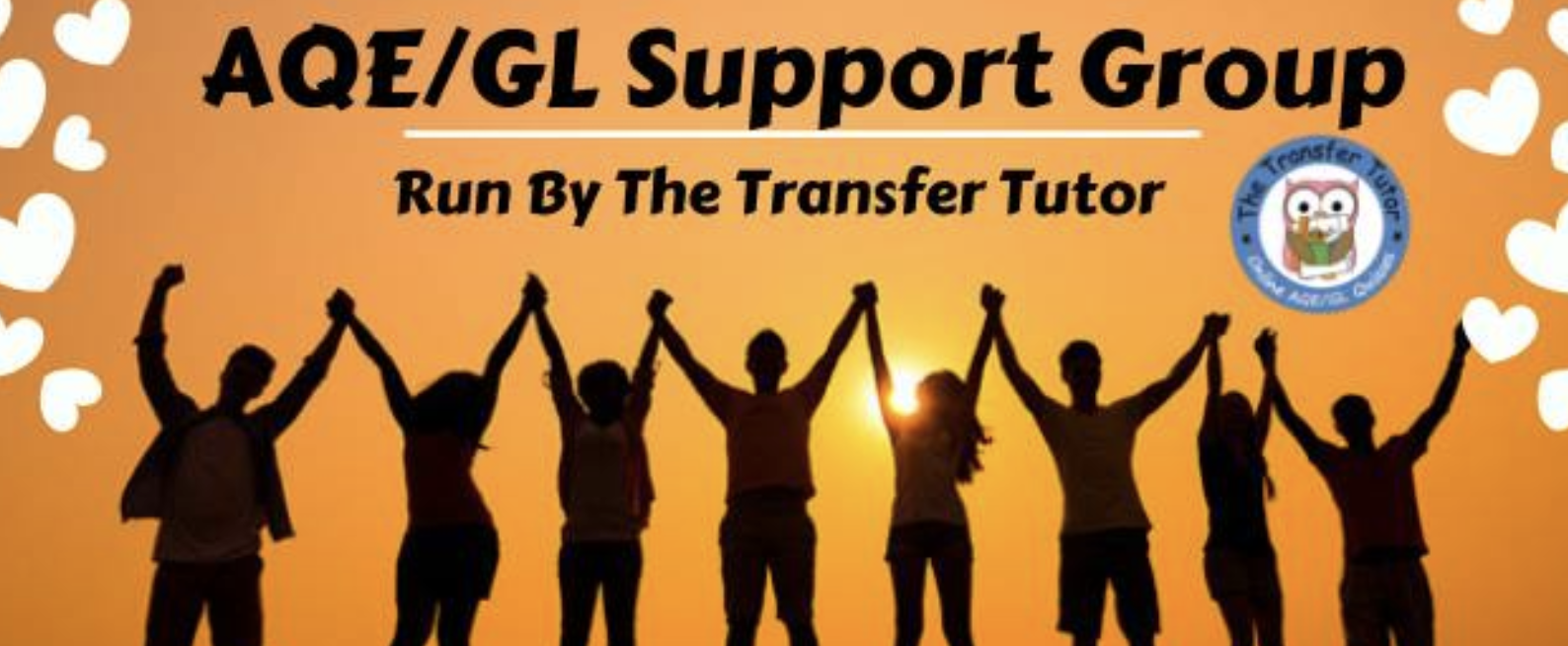The SEAG test is based on the Northern Ireland Curriculum KS2 which is exactly what the child will be learning in school, so that is good news as it should not be anything extraordinary. This is a summary of the full specification which can be found on the SEAG website but this is a breakdown and commentary for overall guidance, direction and support.

Mathematics (SEAG)
The SEAG Mathematics assessment is based on the Northern Ireland Curriculum for Key Stage 2 and tests a variety of mathematical skills and candidates will demonstrate skills across several key areas, including Number, Measurement, Shape and Space, Money, Probability, and Data Representation.
This is my personalised interpretation of the maths section that will be tested during the day and includes examples to hopefully make it easier to understand but if you want to see the SEAG Specification as it is published you will find that on the SEAG website.
Mathematics Overview for the SEAG Test
The SEAG assessment tests pupils’ knowledge and skills in Mathematics, based on the Key Stage 2 curriculum for Northern Ireland. The test will focus on the following key areas:
1. Number
Pupils will need to show a strong understanding of numbers and how they work in different contexts. This includes:
- Whole Numbers & Value
Understanding how digits signify value, such as recognising that in the number 634, the 6 represents 600.
Example: In 432, the digit 4 is worth 400. - Decimals & Multiplying/Dividing by 10, 100, and 1000
Pupils should be able to work with decimals up to two decimal places and understand how to shift decimal places when multiplying or dividing by 10, 100, or 1000.
Example: 1.5 × 10 = 15, 3.75 ÷ 100 = 0.0375. - Estimates and approximations to nearest 10 or 100
Pupils should round numbers to the nearest ten when estimating. Example: Estimate 48 + 37.
Round 48 to 50 and 37 to 40.
50 + 40 = 90 (Estimated sum)
For very large numbers, pupils will round to the nearest 100 for quick estimation.
Example: Estimate 3476 – 1322.
Round 3476 to 3500 and 1322 to 1300.
3500 – 1300 = 2200 (Estimated difference) - Addition & Subtraction
Pupils should be comfortable adding and subtracting numbers mentally, including two-digit numbers and decimals.
Example: 58 + 23 = 81, 4.56 – 2.1 = 2.46. - Fractions, Decimals, and Percentages
Pupils need to understand relationships and equivalence between fractions, decimals, and percentages.
Example: 1/2 = 0.5 = 50%. - Patterns & Sequences of Whole Numbers
This involves recognising and predicting regular sequences of numbers and examples include:
– Steps: Counting by 2s, 5s, or 10s: 2, 4, 6, 8, 10…
– Doubling: Numbers that double: 1, 2, 4, 8, 16…
– Halving: Numbers that halve: 16, 8, 4, 2, 1…
– Multiplication Patterns: Multiplying by the same number each time, like 5, 10, 15, 20…
– Predicting Numbers: Recognising a pattern and predicting the next number, e.g., 3, 6, 9, 12… (next is 15). - Prime, Square, and Cube Numbers
Pupils should know prime numbers (numbers divisible only by 1 and themselves), square numbers (like 4, 9, 16), and cube numbers (like 8, 27, 64).
Example: The square of 5 is 25, and the cube of 3 is 27. - Triangular Numbers or a Series
Triangular numbers are numbers that can be arranged into a triangle. They follow a pattern where each number is the sum of consecutive integers.
Example:
1st triangular number: 1
2nd triangular number: 1 + 2 = 3
3rd triangular number: 3 + 3 = 6
4th triangular number: 6 + 4 = 10
5th triangular number: 10 + 5 = 15
So, the first few triangular numbers are: 1, 3, 6, 10, 15, …
These numbers can be visualised as dots forming a triangle. - Using Letters in Simple Equations
Pupils will need to solve simple equations like 6 + a = 10.
Example: If 6 + a = 10, then a = 4.
2. Measurement
Pupils will be tested on their understanding of measurements such as length, weight, volume, time, and temperature.
- Converting Units
Pupils should be able to convert between units like grams and kilograms, or centimetres and metres.
Example: 250 cm = 2.5 m. - Reading Scales and Temperatures
Pupils will need to read temperatures on scales and understand both positive and negative temperatures (Celsius only).
Example: If the temperature is -3°C and it rises by 5°C, the new temperature is 2°C.
Pupils will also be expected to use scale for measuring distance. - Time
Pupils should know how to read both 12-hour and 24-hour clocks and understand timetables for associated worded maths problems.
Example: 14:30 on a 24-hour clock is 2:30 PM. - Volume, Area and Perimeter
Pupils should be able to calculate the perimeter and area of simple shapes and they may be asked to count squares for area and cubes for volume of two and three dimensional shapes, as well as working with the numbers from a maths problem.
Example: The perimeter of a rectangle with length 4 cm and width 3 cm is 2 × (4 + 3) = 14 cm. The area is 4 × 3 = 12 cm².
3. Shape and Space
This area tests pupils on their knowledge of 2-D and 3-D shapes, angles and symmetry.
- Identifying Shapes
Pupils should be able to identify regular (equal sides and angles) and irregular shapes and the should be able to identify squares, rectangles, quadrilaterals (four-sided shape with four straight edges), circles, triangles (right-angled, equilateral, isosceles and scalene) and polygons (a 2-D shape with straight sides and fully enclosed with at least three sides).
Example: A square has four equal sides and four right angles.
Example: Quadrilaterals include rhombus, parallelogram, trapezium and kite.
Example: Regular Polygons include pentagon (5-sides), hexagon (6-sides), heptagon (7-sides) and octagon (8-sides, like a STOP sign). - 3-D Shapes
Pupils will need to recognise and describe 3-D shapes like cubes, cones cylinders, spheres, triangular prisms and pyramids.
Note – Although the SEAG specification doesn’t expand further than ‘pyramid’, you may want to make sure you know there are two pyramids, including a square-based pyramid and also a triangular pyramid which is also known as a regular tetrahedron.
Example: A triangular pyramid has a triangle at the bottom and 3 triangle faces, 4 vertices and 6 edges. - Turns & Directions
¼ turn (90°), ½ turn (180°), ¾ turn (270°), and a whole turn (360°). Understand clockwise and anti-clockwise directions, eight compass points, and plotting coordinates. - Language and Properties of Lines and Angles
Pupils should be familiar with the terms – Vertical (up-down), horizontal (left-right), perpendicular (right angles), and parallel (equal distance and never meet) along with angles: acute (<90°), obtuse (>90°), and reflex (>180°). - Line symmetry is when a shape can be folded along a line, and both halves match exactly. Common regular shapes and their lines of symmetry include:
Square: 4 lines of symmetry (2 diagonals, 1 horizontal, 1 vertical)
Rectangle: 2 lines of symmetry (1 horizontal, 1 vertical)’
Equilateral Triangle: 3 lines of symmetry (all passing through a vertex and the midpoint of the opposite side)
4. Money
Pupils will solve problems using addition, subtraction, multiplication, and division in the context of money.
- Problem-solving: Using addition, subtraction, multiplication, and division to solve money-related problems.
Example: You buy 3 items costing £4.50 each. What is the total cost?
£4.50 × 3 = £13.50. - Estimation and approximation: Making quick calculations or rounding amounts to estimate prices or costs.
Example: Round up to estimate the cost of 7 items that each cost £3.90 each.
Rounding £3.90 up to £4.00, 7×4=28 so £28.00 - Computation of change: Calculating the correct change for transactions up to £10.
Example: You pay £10 for a £7.25 item. How much change will you receive?
£10.00 – £7.25 = £2.75 change. - Interpreting a calculator display: Understanding how to read and interpret numbers and results on a calculator when solving money-related problems.
Example: After calculating the cost of 5 items at £2.99 each by 5 x 299, the calculator displays 1495 so you will know know the total cost is £14.95.
5. Probability
This section covers the basics of probability, including:
- Understanding Likelihood
Pupils will understand terms like “certain” “uncertain” “likely” and “unlikely” and be able to put them in order of likelihood.
Example: It is certain that that the sun will rise in the morning.
Pupils must also understand the term “fifty-fifty” which refers to the equal chance.
Example: The chance of landing on a heads after tossing a coin is fifty-fifty. - Calculating Probability
Pupils will also be expected to calculate simple probabilities.
Example: The probability of flipping a head on a fair coin is 1/2 or the probability of rolling a 3 on a fair die is 1/6, since there are six possible outcomes.
6. Data Representation
Pupils can be tested on their ability to record, interpret and represent data using various methods, such as graphs, tables and diagrams and the SEAG Specification refers to Venn diagrams, block graphs, bar charts, bar-line graphs and line graphs with axis starting at zero.
- Graphs and Charts
Pupils may interpret data in pie-charts, frequency tables and tallying methods.
Example: If a pie-chart shows the number of apples sold per day, pupils may be asked to identify the day with the most apples sold. - Mean and Range
Pupils will calculate the mean and range of a set of data.
Example: Calculate the mean and range of these numbers – 2, 4, 6 and 8.
The mean is (2 + 4 + 6 + 8) / 4 = 5.
The range is 8 – 2 = 6.
What the students WILL NOT need to know:
- Imperial units (like pounds, feet, etc.).
- Advanced concepts like congruence in 2D shapes.
- They will also not be expected to measure or draw angles (they’ll only deal with internal angles of triangles and quadrilaterals).

English SEAG
English Section of the SEAG Entrance Assessment
The English part of the SEAG assessment checks how well children understand and use language. It follows the Northern Ireland Curriculum for Key Stage 2 (ages 10-11) and focuses on two main areas: Reading and Writing.
Reading and Understanding Texts
Children will be asked to read different texts and show they can:
- Understand the meaning of the text and the ideas behind it.
- Recognise how writers use language to grab the reader’s attention. For example, a writer might use descriptive language to paint a vivid picture, like describing a sunset as “burnt orange and glowing.”
- Think about what the writer is trying to say, sometimes making inferences (reading between the lines) to understand the deeper message.
Writing Skills
Children will need to show they can:
- Use spelling, punctuation, and grammar correctly to make sure their writing is clear. For example, using capital letters at the start of sentences and full stops at the end.
Let’s break down what children will be assessed on:
Comprehension
Children will be expected to:
- Locate and select information from a passage or text. This means finding key details to answer questions.
- Example: After reading a short story, they might be asked to find the main character’s name or what happens next in the story.
- Interpret passages literally (what the words directly mean) and inferentially (reading between the lines).
- Example: In a poem, they may need to figure out the mood of the writer based on word choices, such as “shivering cold” indicating a sense of fear.
- Understand different styles of writing, including poetry, prose, fiction, and non-fiction.
- Recognise and respond to the style and form of writing, knowing how to adapt to different types of texts.
- Example: Understanding that a news article uses formal language, while a story might use more descriptive, informal language.
- Understand how writers use language to grab attention or make an impact.
- Example: Recognising how a writer might use repetition for emphasis, like “I want this, I need this!”
Spelling and Punctuation
Children will need to show they can:
- Proofread short passages to spot and correct spelling and punctuation errors.
- Example: Finding errors like missing commas, or incorrect spellings such as “there” instead of “their”.
- Understand and correctly use punctuation like capital letters, full stops, commas, colons, semi-colons, question marks, exclamation marks, apostrophes, and quotation marks.
- Example: Knowing that quotation marks are used when writing someone else’s words, like: He said, “I love ice cream!”
- Recognise and apply UK spelling rules, such as using “colour” instead of “color”.
- Understand tricky words and spelling rules, like the difference between homophones (words that sound the same but are spelled differently), such as there, their, and they’re.
Grammar and Syntax
Children will be assessed on their understanding of:
- Nouns, pronouns, verbs, adjectives, adverbs, conjunctions, and prepositions.
- Example: Recognising a verb like run (action) and an adjective like happy (describes a noun).
- Verb tenses, including present, past, future, and conditional (will, would).
- Example: “I seek help” (present) vs. “I sought help” (past).
- Understanding the use of abbreviations like they’re (they are), could’ve (could have), etc.
- Plurals, including unusual forms like oxen (plural of ox) and knowing that not all plurals end in “s” or “es”.
- Using comparative (bigger) and superlative (biggest) forms of adjectives and adverbs.
- Knowing what makes up a phrase, sentence, paragraph, and chapter.
Vocabulary
Children will be assessed on:
- Understanding the meaning of words selected from the reading passages.
- Synonyms (words with similar meanings) and homonyms (words that sound the same but have different meanings), which are commonly used in everyday language.
- Example: Cold and chilly are synonyms, while bear (the animal) and bare (without covering) are homonyms.
How Are Children Assessed In Reading?
- Texts to Read: The texts children read could include stories, poems, and factual information. They’ll need to show they understand the different types of writing and who the writing is aimed at (e.g. a story for children or a news article for adults).
- How to Respond: Children will not need to write long essays. Instead, they may answer questions in one or two sentences.
- Handwriting doesn’t matter, so marks aren’t given for neatness.
How Are Children Assessed In Spelling, Punctuation & Grammar?
- There will be 5 questions at the start of the SEAG Test focused specifically on Punctuation, Spelling & Grammar
- In Grammar, there will be multiple choice with five options to choose from and select the right answer
- In Punctuation and Spelling, there are four main options to select the correct answer, including a fifth option of ‘No Mistake’ N.
More about The Transfer Tutor App

The Transfer Tutor App is an online site dedicated to providing fun and interactive quizzes aligned directly to the SEAG /GL specification. All quizzes are broken down into manageable topics and can be done on any mobile or tablet device, so it’s a great way for kids to learn and prepare for the test.
There are many, great features including (but not limited to):
- Quizzes broken down into specific English and Maths topics, to allow for focused learning and the ability to hone in on areas of weakness.
- Mobile friendly and works on any internet device.
- ‘Hint’ option supports the child’s learning. For example, in question about calculating area of an irregular shape, the hint will say, “Break it into two” – enough to keep the child going but teaching them for future, similar questions.
- The Leaderboard at the end makes the child feel like they’re playing a game and having friendly competition.
- Good use of colour and graphics which makes it exciting.
- Parents receives a progress email at the end to let them know how their child did.
How To Buy

All normal licences are a simple, one-off payment (except the monthly subscription of course) and they can be purchased in confidence through a normal PayPal account or using a normal bank card and the Guest option.
Licences are purchased depending on the length of time required and as additional years are only charged at £20 per year, it’s worth considering a longer licence if you have a younger sibling.
Click the button below or here to explore the licences.
For any further questions, please contact me or check out the Frequently Asked Questions page.
Google Reviews:

Check out the Google Reviews to read what other customers felt about The Transfer Tutor.
Spoiler alert – all the kids (the most important people) and parents love it!
Social Media Links – Keeping Up To Date

Follow or like The Transfer Tutor on your social media channel of choice and ensure you never miss a beat with the whole transfer process, handy tips, advice, special offers and competitions.
Click below for your preferred channel or search for @TransferTutorHQ wherever you are.
Free Facebook Group

You may have read in the reviews about people referring to the Facebook Support Group and this is certainly a great place to keep informed, ask questions, get support and keep up-to-date with anything happening in the transfer space.
It’s free to join but please ensure you have a genuine Facebook profile picture (ghost pictures are not approved as not deemed authentic) and then simply click here and answer the simple questions -> Join Facebook Group.
